My personal framework for flourishing
Flourishing is a wonderful word. I first encountered it during my philosophy classes, while discussing its Greek translation, eudaimonia (εὐδαιμονία). The Greek word can also be loosely translated as happiness or welfare. As Aristotle says :
[Ch 9] …Happiness (eudaimonia) comes to one by means of virtue and some sort of learning or training… [Ch 5] virtues are neither feelings nor predispositions…they are active conditions (hexis). (Nichomachean Ethics, 2002)
Flourishing is not permanent—you may have it now but can lose it later. Rather, it is an active condition (ἕξις) you have to maintain. As an engineer, I always think of it as a steady-state: a state brought about by your system of actions, habits, and decisions. It reminds me of this graph from my control systems days:

When a change is introduced in a system, its response oscillates for some time until it reaches steady-state. However, it’s not final. New disruptions can cause it to oscillate again. Steady-state is a condition a system should actively maintain.
With that as a jump-off point, I tried to come-up with a simple framework to determine if I’m flourishing. After some reflection of my past experiences, I arrived at the following:
I know I’m flourishing if I can answer ‘yes’ to these three questions: “am I building?,” “am I playing?,” and “am I earning?”

Building, playing, and earning.
In this blogpost, I’ll talk about my personal framework based on these pillars, and how they guide my decisions— both in career and life. I am aware that this may not work for everyone, but I hope that it resonates with you in some way.
The three pillars
First, I want to talk about what each pillar stands for, and why they are important to me. My rule of thumb is that when choosing a career or a long-term investment, it should satisfy at least two of the three pillars.
Building
Building is a pillar that I’ve attached myself early on. Heck, even my Twitter bio says “I build things.” I appreciate the joys of my craft, and I’ve come to see the world through its lens. Building something tangible sometimes speaks to our primal desire to outlive ourselves.

Right now, software is my medium. It has the capacity to make significant and positive impact to many. Moreso when you’re building in public and working in open-source: the presence of a community drives your growth.
As an aside, open-source has definitely been a multiplier for me—and I long to work on it in a more frequent basis. It just started with a small project, then this blog, and it resulted to a lot of opportunities that I don’t think I’ll be able to get if I didn’t build or learn in public.1
Lastly, creating caters both to utility and self-expression, especially for software. I was able to create functional artifacts like search engines and optimizers to something more artistic like generative art and games. Building is a verb that I’m betting on, and I think that I’m getting good returns so far.
Earning
Earning is a pillar that I’ve come to appreciate recently. Living in the Philippines during the height of the COVID pandemic sucks,2 and I got lucky to have the financial cushion brought by my previous software development job.
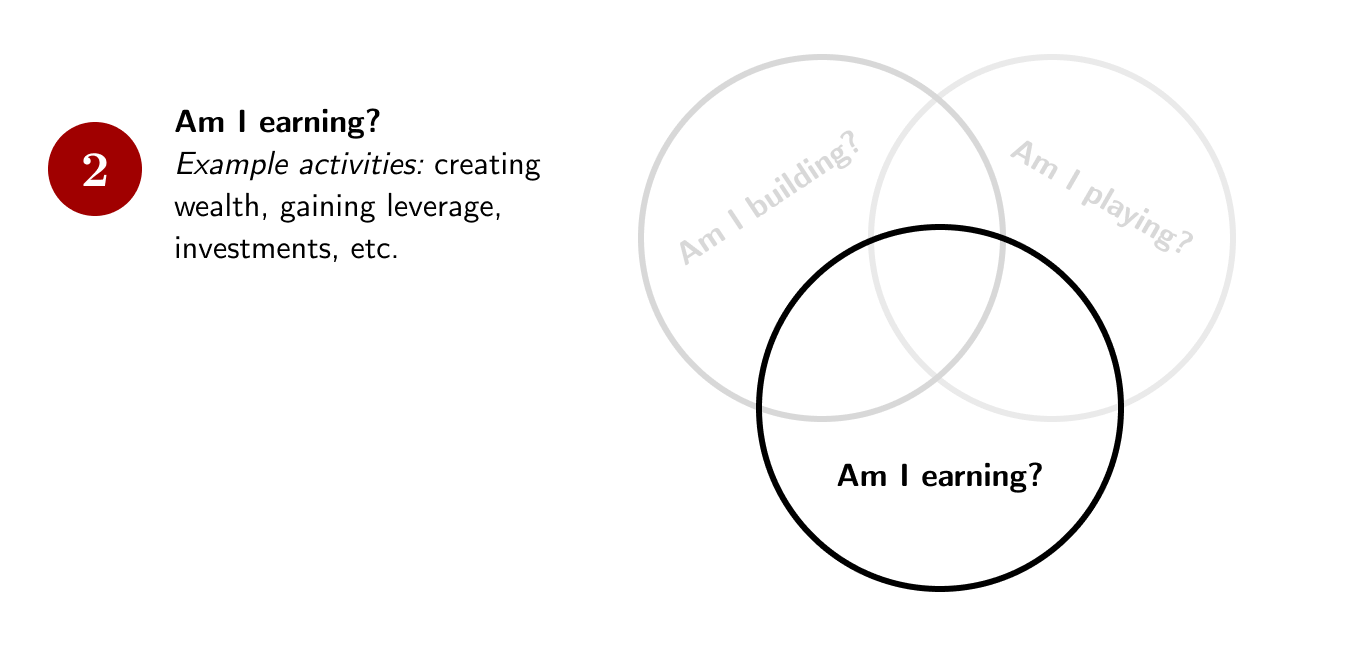
I’d like to think that I have a healthy relationship with money. I try not to attach my self-worth on it too much, and keep a certain level of detachment as I accumulate it. Instead, I see earning as wealth, something more innate, not just what’s written in my annual tax returns. I always think that creating wealth is a combination of skill and luck.
- Skill: I like what Naval said that if he loses his money and be dropped on a random street, he can be wealthy again in a few years because he has the skillset to regain it. Wealth is created through leverage and skill.
- Luck: Chance often plays a huge part in creating wealth. Sometimes, it’s just being in the right place at the right time. However, it’s possible to create luck, i.e., to sniff out where the potential right place and right time will be.
Inasmuch as I scoff at the overt seriousness and cult-like following of most tech personalities, their ideas on wealth often have a grain of truth. It’s useful, and highly-adjacent with respect to my field in tech. And yeah, I also need to pay the rent.
Playing
Playing is a pillar that feeds into what I do. It’s the idea of following my whims, blue-sky thinking, and doing things just for fun! We often get caught up with outcomes, taking the process for granted. Although I like achievements, too much fixation on output without the space for creativity and variety will inevitably tire me out.

Looking back, I also learned my craft by playing: building Pyswarms isn’t a requirement,3 it’s something that I did for fun! This blog also follows the same principle: I write about anything whenever I want. There’s some level of attention brought forth by playing— directionless, yes, but meaningful.
One of my favorite anecdotes is on how Feynman got his Nobel prize:
“So I got this new attitude. Now that I am burned out and I’ll never accomplish anything, I’ve got this nice position at the university teaching classes which I rather enjoy, and just like I read the Arabian Nights for pleasure, I’m going to play with physics, whenever I want to, without worrying about any importance whatsoever.” (Feynman, 1985)
That’s when he came across the wobbling plates in the cafeteria, which led him to figure out the motion of mass particles, that paved the way to our understanding of electrodynamics today.4 Sure, I’m far from Feynman,5 but I believe that I can benefit from this attitude too.
Lastly, I’d like to mention that my view of playing may be adjacent to the act of betting or prospecting. Having multiple possibilities (variety) and the freedom to explore them (prospecting) can lead to serendipitous acts of innovation.
Pillars in tandem
Earlier, I hinted about my go-to decision framework using these pillars: it should satisfy at least two of the three. In this section, I’d like to explore the dynamics of each pair. What happens if I’m in a position where only two exists?
Build and Earn
Building and earning sounds like a nice combination. For me, it’s a classic example of “what if your hobby becomes your job?” However, there’s often a risk of falling out of love from your hobbies because your livelihood is attached to your creative output.
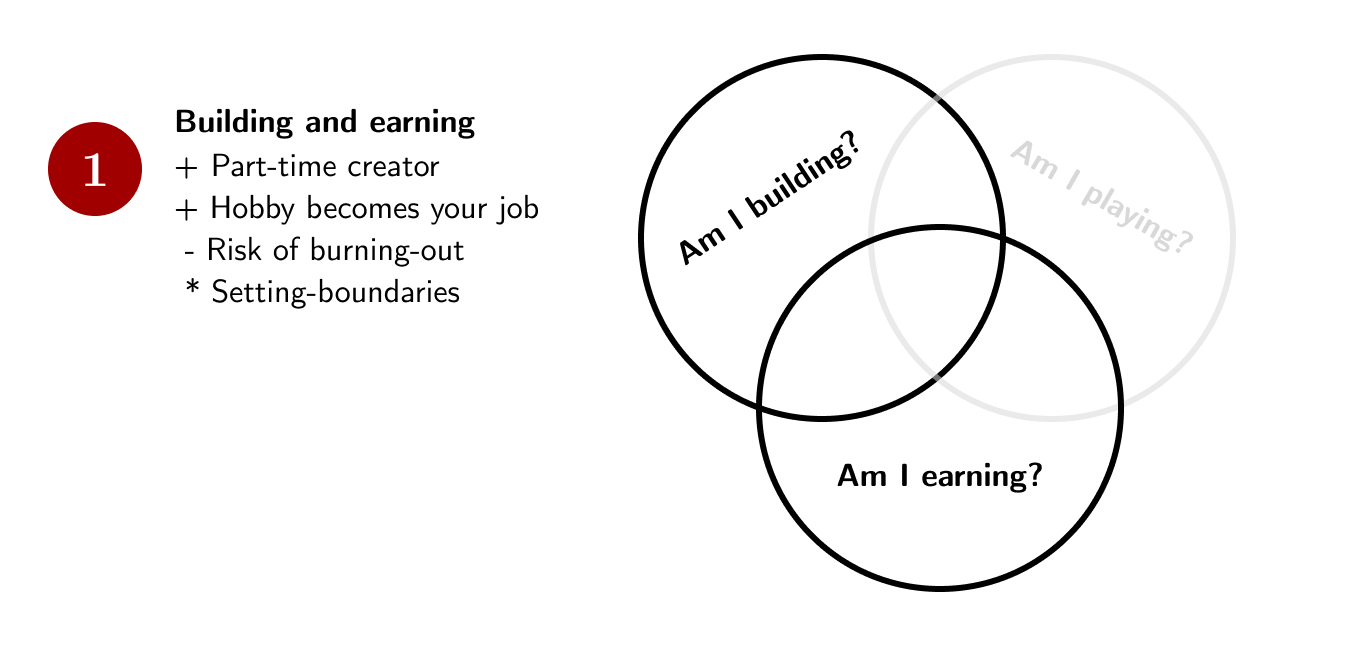
Oftentimes, a day job is like this: I get to build and earn. I’m definitely one of the lucky few whose obsessions are highly valued by society today. But without play, the fire of delight, carefree, and joy might extinguish —it’s something I want to avoid!
I’ve come to realize that I just need to accept it, as this is going to be the case 99% of the time. My go-to strategy is to set boundaries, find play outside of work, and separate the programming I do for my job from the programming I do for myself.6 During these moments, I was able to build a game and write more in my blog while being productive at work!
Build and Play
Another interesting tandem is building with unabashed creativity. It reminded me of grad school.7 There’s building in the form of research and open-source, then there’s playing in the form of freedom and the variety of topics you can work on.8
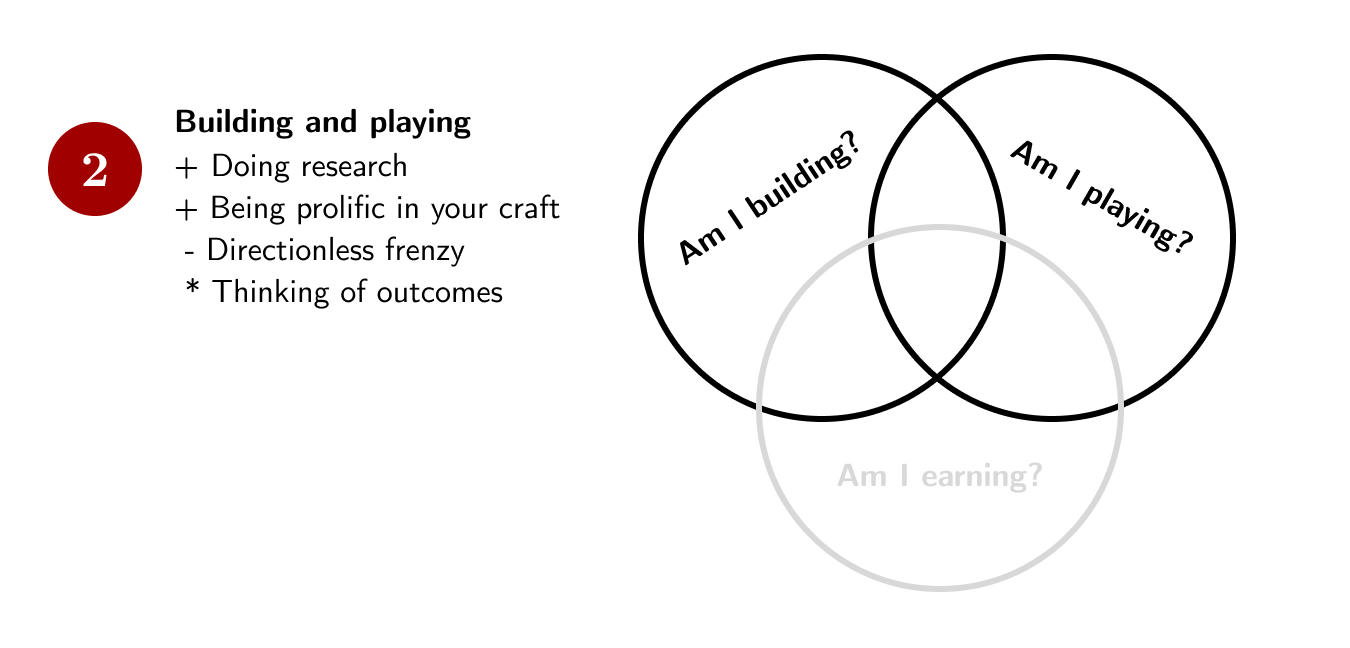
I’m a bit biased because my best experiences came from these moments. Perhaps it’s because I didn’t assign much weight on money back then—it’s different now.
However, the combination of building and playing made me prolific in what I do: publishing more than my peers, starting an open-source project, landing on good internships, starting this blog, finishing my thesis ahead of time, and more! It was a good experience!
Of course, money is still a good indicator of value. I may have published a lot, but their impact is gated behind paywalls and what-not. I may be proud of my thesis, but I guess only my panel has read about it. My previous consulting experience has tamed my building frenzy: it directed my energy.
Earn and Play
Earning and playing in tandem is something that I haven’t done, so I can only speculate. I always imagine this as working on things that are lucrative, yet doesn’t involve creation. Moreover, the prospecting and betting aspects of play become more apparent.
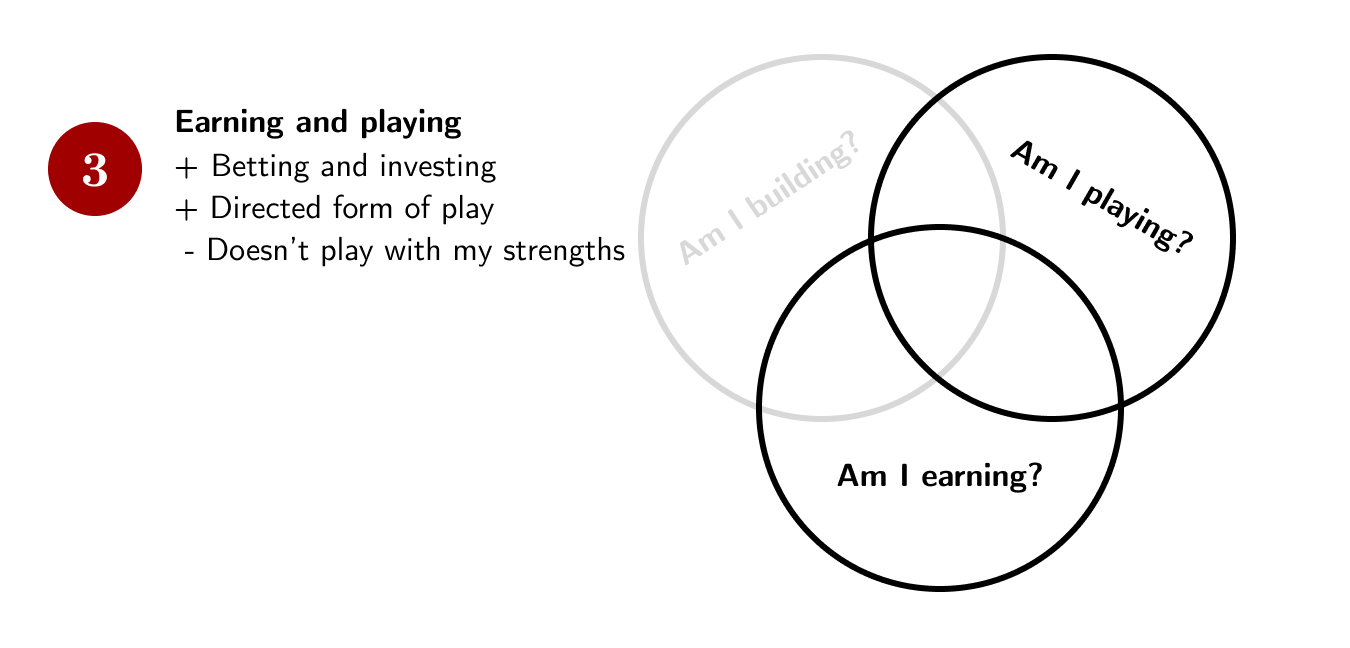
In my opinion, investing on crypto falls under this category: you don’t necessarily “build” something, but the game itself can net you some wealth. Investing involves a lot of speculation, blue-sky thinking, and risks. However, unlike Build and Play, you are measuring your moves with an outcome. Your financial returns depend on when you hold and sell.
Perhaps it’s the reason why I’ve never gotten into it yet— I value building so much. To be honest, crypto-trading feels dodgy at the moment. With all the memes, laser-eyed profile photos, and cult-like facade, it just sets off all my alarms. Nevertheless, it’s an interesting concept to entertain. From a build standpoint, I like its promise: a decentralized financial system ran by the public, just like open-source! I’ll probably write about this again in the future.
Navigating this framework
In this section, I’ll talk about how I navigate this threefold framework. There’s a common approach in Venn diagrams where you always want to be in the intersection of all three—it’s ideal, but not practical. Nevertheless, moving oneself to that center can become your north star.
Ideally, you get all three. A misconception we’re often fed is to find that one job or one career that will allow you to flourish. There will always be tradeoffs in build, earn, and play. Moreso if you factor in your priorities at your current life-stage.
I’ll talk about two realistic strategies. The first works on a micro-level, based on your primary career. The second takes things holistically, and requires you to evaluate all aspects of what you do.
“Take two then till the third”
Here, I expand upon my go-to strategy of “choosing an option that satisfies two out of the three pillars.” I call this Take two. It’s practical, for most options within your horizon won’t necessarily cater to all three. Again, this doesn’t mean you settle for the first two, getting all three is still the aspiration.
But as we’ve seen from the previous section, there are tradeoffs when a pillar is missing. Building and Earning without Playing may lead to fatigue. Building and Playing without Earning is directionless. Earning and Playing without Building is uninspiring.
Just like in our steady-state graph, we need to course-correct. That’s when you till the third. Like tilling the land, you prepare a space to cultivate the missing pillar. It may be outside of work or during the weekends— just something to nourish your soul. With that said:
“Take two then till the third:” choose an option that satisfies two, then cultivate the missing third
Hobbies are definitely a perfect example of this. Most jobs give you the opportunity to build and earn, but not much room to play. You can’t really just introduce any other tech, or any other framework in your next sprint, but you can in your weekend projects. Making art, having fun, and “directionless” work is soulcraft (Crawford, 2006). You can just make nothing, and it’s fine (Odell, 2020).
Holistic view
Finally, it’s also possible to look at all your activities in a more holistic manner. Each one— your day job, side-project, side-gig, community work, etc.—contributes to your total build-earn-play account. Think of this as an adoption of Bentham’s felicific calculus.
This is not an exact science. I don’t even think this is a science at all! It is simply guesstimation based on your personal experiences. What this holistic view tries to impart is that:
- Each activity provides varying degrees of build, earn, and play (high positive value).
- Some activities don’t provide one of the pillars (zero-value), and
- Some activities even hamper you from experiencing some of these pillars (negative-value).
You can then take the aggregate of those values and compute your net build-earn-play score. You’re free to set the scale and the thresholds where things may be considered critical. Sometimes, our life-stage forces us to prioritize one pillar over the other.
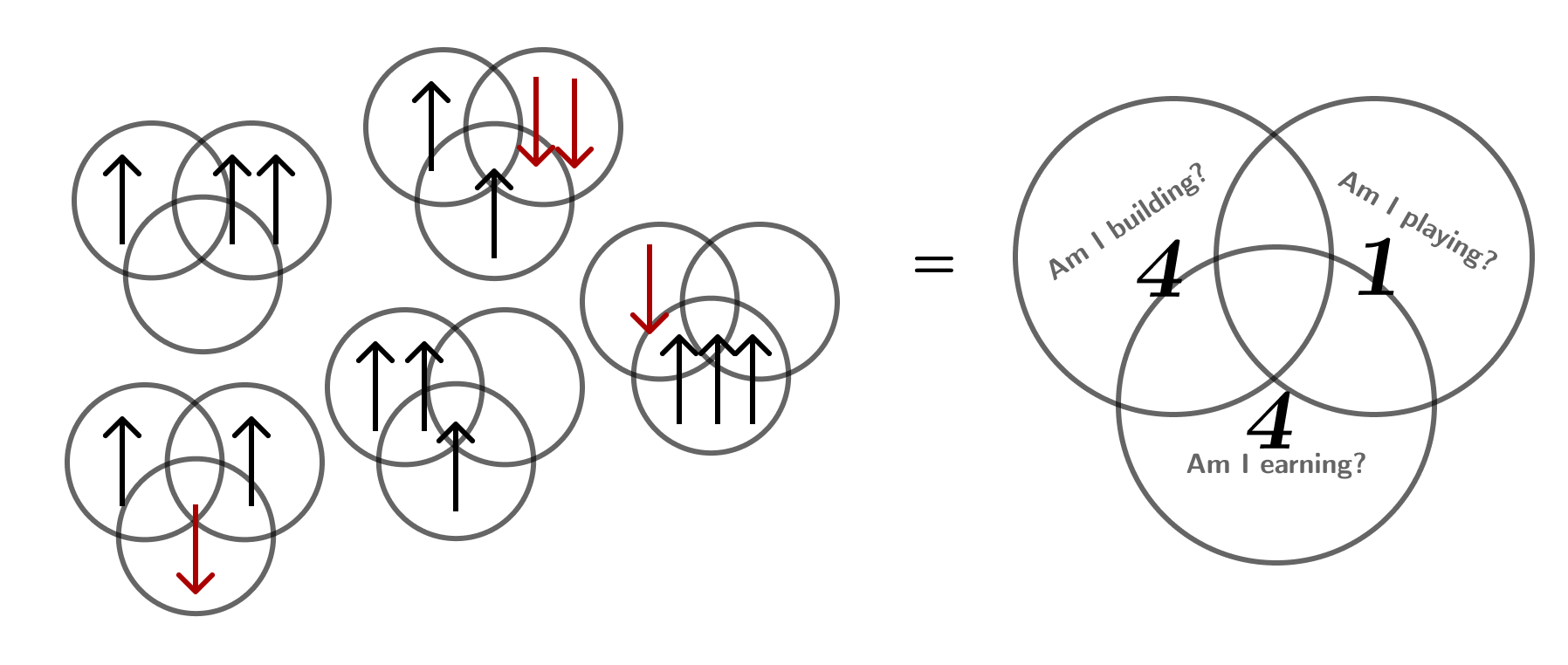
In the end, it’s up to you if the values you’ve arrived at is enough for you to flourish. Personally, I don’t overdo this, it’s more of a napkin-math computation that I keep in my mind.
A word of note
As always, treat these frameworks as guideposts. The worst is that we get obsessed asking ourselves if we’re building, playing, or earning, that we cease to flourish in the process. The structure we’ve built from these pillars can also turn into self-imposed prisons.
Perhaps unhappiness can have its own dignity and may also shed light to who we are as much as happiness (Popova, 2013). I truly believe that. There’s no better way to put this than Camus:
It is not true that the heart wears out — but the body creates this illusion.
Those who prefer their principles over their happiness, they refuse to be happy outside the conditions they seem to have attached to their happiness. If they are happy by surprise, they find themselves disabled, unhappy to be deprived of their unhappiness. (Camus, “Notebooks 1951-1959”, 2008)
Conclusion
In this blogpost, I reflected upon my personal framework to determine if I’m flourishing. I treat it as a steady-state system consisting of three pillars: building, earning, and playing. I talked about how they work in isolation and in tandem.
Then, I discussed how I approach this framework in a micro and macro level. My first strategy is to always take-two, then find means to cultivate the third. My second strategy is to perform a back-of-the-envelope computation to see my “levels.” Note that these are all guesswork and estimation, not an exact science.
These things may not apply to you. Perhaps building is not your thing, and there’s another verb that resonates with you more. No worries, I think even just the three-fold structure can help you form your own framework.
I write this during a transition period of my life, as I have always done since . I think it’s a perfect time to reflect and reevaluate my views on work, career, and hobbies. Of course, I’m still young, and this is not perfect. Perhaps the 30-year old me will cringe at reading this, but I hope . . . that he never stops building, earning, and playing.
Many thanks to Avic, Reena, and Jason for reading early drafts of this work.
References
- Aristotle, Nicomachean Ethics, translated by Joe Sachs, Focus Philosophical Library, Pullins Press, 2002.
- Camus, Albert Notebooks 1951-1959, translated by Ryan Bloom, 2008. Note: if you read the References section then lucky you! Trivia, the “Notebook” section of this blog was inspired by this title!
- Crawford, Matthew B. “Shop class as soulcraft.” The New Atlantis 13 (2006): 7-24.
- Feynman, Richard, Surely you’re joking, Mr. Feynman!, W.W. Norton & Company, 1985.
- Odell, Jenny. How to do nothing: Resisting the attention economy. Melville House Publishing, 2020.
- Popova, Maria. “Albert Camus on Happiness, Unhappiness, and Our Self-Imposed Prisons”, Brain Pickings, 2013. Available: https://www.brainpickings.org/2013/11/07/albert-camus-notebooks-happiness/. [Accessed May 17 2021]
Footnotes
-
I like Shawn Wang’s idea of Learning in Public. I encourage everyone to read that. ↩
-
It’s already been a year and I can’t see the COVID situation in the Philippines getting better. ↩
-
Sure, writing a particle-swarm optimizer was done as an assignment at school, but creating an open-source package with tests and everything is something that I did to satisfy my whims! ↩
-
Very far… ↩
-
My common tactic here is to choose a technology that is very far but potentially useful to my work. I usually do machine learning in Python, so my weekends are often filled with side-projects in Elixir, Godot, and Pico-8! ↩
-
I may not be earning a “traditional salary” while I was in Japan, but the MEXT scholarship was generous enough on our monthly stipend that I was able to obtain health benefits, travel a lot, enjoy Japan, and even save money by the time I went home. ↩
-
I am quite aware that academia isn’t always like this. Others’ grad school experience is not as freeing as I had. I got extremenly lucky working under a kind professor (thanks Furuzuki-sensei!), a fun laboratory, and nice environment. ↩